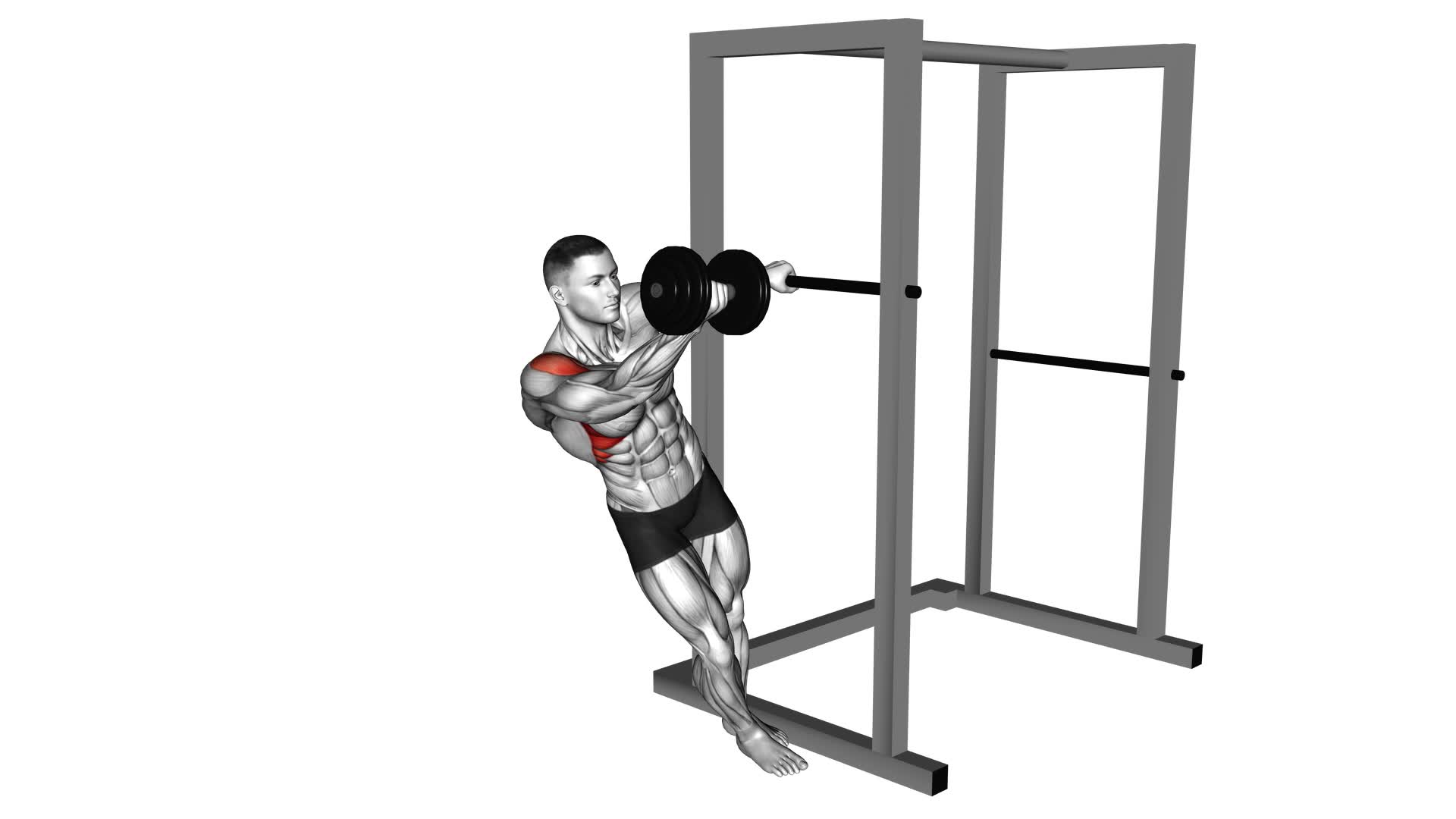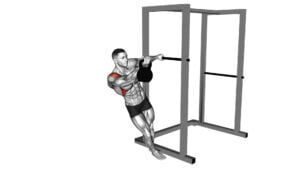Dumbbell Learning Front Raise (male) – Video Exercise Guide & Tips

Looking to strengthen your shoulders? Check out this video exercise guide for the dumbbell front raise.
Watch This Exercise Video
This exercise is perfect for men who want to target their shoulder muscles and improve their upper body strength.
Learn about the benefits of the dumbbell front raise, proper form and technique, and how to choose the right weight.
Avoid common mistakes and discover variations to challenge yourself.
Incorporate dumbbell front raises into your shoulder workout routine for impressive results.
Key Takeaways
- Dumbbell front raises target and strengthen shoulder and upper body muscles.
- Proper form and technique for dumbbell front raises include standing with feet shoulder-width apart, holding dumbbells with palms facing thighs, and lifting the dumbbells in front while keeping elbows slightly bent and wrists neutral.
- Choosing the right weight for dumbbell front raises is important to challenge the muscles while maintaining proper form and avoiding injury.
- Common mistakes to avoid during dumbbell front raises include using momentum, lifting weights above shoulder level, maintaining a neutral spine, and not gripping weights too tightly.
Benefits of Dumbbell Front Raises for Men
By performing dumbbell front raises, you can effectively target and strengthen the muscles in your shoulders and upper body. This exercise is particularly beneficial for strength training as it helps to develop and tone the muscles in your deltoids, which are responsible for shoulder abduction and flexion. Additionally, dumbbell front raises also engage the muscles in your trapezius, biceps, and forearms, providing a comprehensive upper body workout.
To ensure proper technique for dumbbell front raises and maximize muscle development, start by standing with your feet shoulder-width apart and holding a dumbbell in each hand, palms facing your thighs. Keep your core engaged and maintain a slight bend in your knees throughout the exercise. Slowly lift the dumbbells in front of you, ensuring that your elbows remain slightly bent and your wrists are neutral. Lift the dumbbells to shoulder level or just above, then slowly lower them back down to the starting position. Remember to keep your movements controlled and avoid swinging or using momentum to lift the weights.
Incorporating dumbbell front raises into your strength training routine can help improve your shoulder and upper body strength, enhance muscular endurance, and promote better overall posture. Make sure to use proper technique and gradually increase the weight as you become stronger to continue challenging your muscles and reaping the benefits of this effective exercise.
Proper Form and Technique for Dumbbell Front Raises
To properly perform dumbbell front raises, you should start by standing with your feet shoulder-width apart and holding a dumbbell in each hand, with your palms facing your thighs. Here are some key points to keep in mind for proper form and technique:
- Keep your core engaged and maintain a slight bend in your knees throughout the exercise.
- Lift the dumbbells in front of you, keeping your arms straight, until they're parallel to the floor.
- Avoid swinging your body or using momentum to lift the weights. Control the movement and focus on using your shoulder muscles.
- Exhale as you lift the dumbbells and inhale as you lower them back down to the starting position.
- Start with lighter weights and gradually increase the resistance as you get stronger.
Proper form and technique are crucial to getting the most out of your dumbbell front raises. By performing the exercise correctly, you can reap the following benefits:
- Strengthening the front and middle deltoids, leading to improved shoulder strength and stability.
- Enhancing shoulder definition and aesthetics.
- Developing better posture by strengthening the muscles that support the shoulder girdle.
Remember to avoid common mistakes such as shrugging your shoulders or bending your elbows during the movement. As you progress, you can try variations like using a single arm or performing the exercise on an incline bench.
Choosing the Right Weight for Dumbbell Front Raises
When selecting the appropriate weight for dumbbell front raises, consider your current strength and gradually increase the resistance as you progress. Choosing the right weight is crucial to maximizing muscle activation and getting the most out of your workout.
Start with a weight that challenges you but allows you to maintain proper form. If the weight is too heavy, you may sacrifice technique and risk injury. On the other hand, if the weight is too light, you may not be effectively stimulating the muscles.
As you become more comfortable with the exercise and your strength improves, gradually increase the weight. This will help you continue to challenge your muscles and promote growth. Remember, it's better to start with a lighter weight and work your way up than to start too heavy and have to decrease the weight.
By choosing the right weight and gradually increasing it over time, you can ensure that you're maximizing muscle activation and seeing progress in your dumbbell front raises.
Now, let's discuss some common mistakes to avoid during this exercise.
Common Mistakes to Avoid During Dumbbell Front Raises
One common mistake to avoid during dumbbell front raises is improper form. Proper technique is crucial for maximizing the effectiveness of this exercise and preventing injury.
Here are some common mistakes to watch out for:
- Using momentum: Swinging the weights up instead of using controlled movements can take the focus away from the targeted muscles and increase the risk of strain.
- Raising the weights too high: Lifting the dumbbells above shoulder level can put unnecessary stress on the shoulder joint, leading to discomfort or injury.
- Arching the back: Maintaining a neutral spine is important during front raises. Arching the back can strain the lower back and reduce the engagement of the shoulder muscles.
- Gripping the weights too tightly: Holding the dumbbells too tightly can cause tension in the forearms and reduce the activation of the shoulder muscles.
- Neglecting proper breathing: Breathing plays a crucial role in maintaining stability and control during exercises. For front raises, inhale as you lower the weights and exhale as you lift them.
Variations and Progressions for Dumbbell Front Raises
To progress your dumbbell front raises, you can try different variations to challenge your muscles in new ways.
One option is to incorporate resistance bands into your workout. This can be done by attaching the resistance band to a stable object and holding the dumbbells while performing the front raise motion. The resistance bands add an extra level of difficulty as they provide constant tension throughout the movement. This variation helps to strengthen your shoulder muscles and improve stability.
Another alternative to traditional dumbbell front raises is the kettlebell front raise. Instead of using dumbbells, you can hold a kettlebell by the handle and perform the front raise motion. The kettlebell's unique shape challenges your muscles in a different way, helping to improve grip strength and overall shoulder stability.
You can also try performing the front raise exercise with a barbell instead of dumbbells. This variation allows you to lift heavier weights and target your shoulder muscles from a different angle.
Incorporating these variations into your routine can help prevent plateaus and keep your workouts interesting. Remember to start with lighter weights and gradually increase the load as you become more comfortable with each variation.
Tips for Incorporating Dumbbell Front Raises Into Your Shoulder Workout Routine
To effectively incorporate dumbbell front raises into your shoulder workout routine, it's important to consider a few key tips.
First, try different variations of front raises, such as alternating arms or using a bench for support, to target different muscles in your shoulders.
Second, focus on maintaining proper form and technique throughout the exercise, keeping your core engaged and your shoulders relaxed.
Lastly, be aware of the benefits of front raises, including improved shoulder strength and stability, and incorporate them into your routine accordingly.
Variations for Front Raises
To enhance your shoulder workout routine, incorporate different variations of dumbbell front raises. Here are some modifications and alternative exercises for front raises to keep your routine challenging and effective:
- Single-arm dumbbell front raises: Hold a dumbbell in one hand and perform the front raise, focusing on isolating each shoulder.
- Alternating dumbbell front raises: Hold a dumbbell in each hand and alternate raising one arm at a time, engaging both shoulders.
- Arnold press: Start with the dumbbells at shoulder height, palms facing you. As you press up, rotate your palms away from you.
- Barbell front raises: Instead of dumbbells, use a barbell to perform the front raise, targeting your shoulders and forearms.
- Plate front raises: Hold onto a weight plate with both hands, thumbs on the inside, and raise it in front of you.
By incorporating these variations, you can target different muscles in your shoulders and keep your routine fresh.
Now, let's move on to proper form and technique for front raises.
Proper Form and Technique
As you incorporate dumbbell front raises into your shoulder workout routine, it's important to focus on proper form and technique.
To ensure maximum effectiveness and minimize the risk of injury, pay attention to the following tips.
First, maintain a neutral spine and engage your core muscles throughout the exercise. This will help stabilize your body and prevent excessive strain on your lower back.
Second, keep your shoulders relaxed and avoid shrugging them up towards your ears. Instead, focus on lifting the dumbbell with your shoulder muscles while keeping your elbows slightly bent.
Lastly, for added variety and challenge, try incorporating one-arm variations into your routine. These variations not only target your shoulder muscles but also help improve shoulder stability.
Benefits of Front Raises
To maximize the benefits of incorporating dumbbell front raises into your shoulder workout routine, consistently perform them with proper form and technique. By doing so, you won't only target your front deltoids effectively but also reap the following benefits:
- Increased shoulder strength and stability
- Improved posture and upper body alignment
- Enhanced muscle definition in the front of your shoulders
- Overall upper body coordination and balance
- Activation of secondary muscles, such as the trapezius and serratus anterior
If you're looking for front raise alternatives, you can try using resistance bands or cables instead of dumbbells. These alternatives provide different levels of resistance and can help add variety to your shoulder exercises.
Remember to always consult with a fitness professional to ensure proper form and technique when incorporating front raises or any other shoulder exercises into your workout routine.
Frequently Asked Questions
How Many Sets and Repetitions Should I Do for Dumbbell Front Raises?
To get the most out of your dumbbell front raises, it's important to choose the optimal weight and find the right number of sets and repetitions. This will vary depending on your fitness level and goals.
Start with a weight that challenges you but allows for proper form. Aim for 3-4 sets of 8-12 repetitions to build strength and muscle.
Can Dumbbell Front Raises Help to Strengthen Other Muscles Besides the Shoulders?
Dumbbell front raises aren't just beneficial for strengthening your shoulders, but also for targeting other muscles in your body. These exercises can help improve your overall strength and stability.
Additionally, there are variations of dumbbell front raises that cater to different fitness levels, allowing you to progress at your own pace.
How Often Should I Include Dumbbell Front Raises in My Workout Routine?
To determine how often you should include dumbbell front raises in your workout routine, consider your exercise frequency and goals.
As a general guideline, aim to perform this exercise 2-3 times per week, allowing for adequate rest and recovery.
You can also incorporate variations and progressions such as increasing the weight, performing supersets or adding other shoulder exercises to challenge your muscles and promote growth.
Always listen to your body and adjust as needed.
Are There Any Modifications or Alternatives for People With Shoulder Injuries or Limitations?
If you have a shoulder injury or limitation, there are modifications and alternatives you can try.
For shoulder injury modifications, you could consider doing exercises that focus on strengthening the rotator cuff muscles or using resistance bands instead of dumbbells.
As for shoulder limitation alternatives, you might want to try exercises that involve lateral raises or overhead presses using lighter weights.
Remember to always consult with a healthcare professional before attempting any new exercises with a shoulder injury or limitation.
Can Dumbbell Front Raises Help to Improve Posture and Shoulder Stability?
Dumbbell front raises can be a valuable exercise to improve posture and shoulder stability. By targeting the anterior shoulder muscles, this exercise helps to strengthen and stabilize the shoulder joint. Additionally, it can also contribute to overall upper body strength.
To perform dumbbell front raises correctly, start with a neutral spine, engage your core, and lift the dumbbells in a controlled manner, keeping your arms straight and parallel to the ground. Remember to avoid any swinging or jerking movements for optimal results.
Conclusion
In conclusion, dumbbell front raises are a beneficial exercise for men to strengthen and tone their shoulder muscles. By using proper form and technique, and choosing the right weight, you can maximize the effectiveness of this exercise.
It's important to avoid common mistakes and consider variations and progressions to keep challenging your muscles.
By incorporating dumbbell front raises into your shoulder workout routine, you can achieve your fitness goals and improve overall upper body strength.

Author
Years ago, the spark of my life’s passion ignited in my mind the moment I stepped into the local gym for the first time. The inaugural bead of perspiration, the initial endeavor, the very first surge of endorphins, and a sense of pride that washed over me post-workout marked the beginning of my deep-seated interest in strength sports, fitness, and sports nutrition. This very curiosity blossomed rapidly into a profound fascination, propelling me to earn a Master’s degree in Physical Education from the Academy of Physical Education in Krakow, followed by a Sports Manager diploma from the Jagiellonian University. My journey of growth led me to gain more specialized qualifications, such as being a certified personal trainer with a focus on sports dietetics, a lifeguard, and an instructor for wellness and corrective gymnastics. Theoretical knowledge paired seamlessly with practical experience, reinforcing my belief that the transformation of individuals under my guidance was also a reflection of my personal growth. This belief holds true even today. Each day, I strive to push the boundaries and explore new realms. These realms gently elevate me to greater heights. The unique combination of passion for my field and the continuous quest for growth fuels my drive to break new ground.







